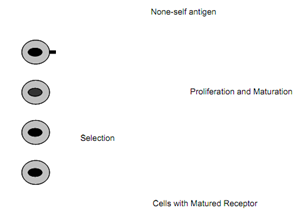Immune Principle
Any element where belonging to body or foreign, such can be acknowledged by immune system, is termed as antigen or self antigen and non-self antigen respectively, the discrimination of that, is based upon receptor molecules there on the surface of immune cells. There are two immune cells also name are: T-cells and B-cells differing in terms of medium needed for the corresponding antibody-antigen interaction along with former introducing freely in solution whereas the latter doing that throughout accessory cells. In these interactions, antibodies (cell receptor, effectively) bind itself to the antigens. Thereafter, via the second signal from the accessory cells via T-cells as assister cells, the antigen stimulates the B-cell to mature and proliferate into another type of cells named as plasma cells. This cell is also known as terminal cells as they do not separate further. In cell division or proliferation, clones are generated that are progenies of a single cell. Such is called clone generation obtains place in order to reach the state of plasma cells as like they are the antibodies' most active secretors on a larger rate than rate of antibody secretion via the B-cells. While an antibody identifies an antigen, then the binding strength is straightly proportional to the affinity.
These biological principles of clone maturation, proliferation and generation are mimicked and incorporated into an algorithm known as the Clonal Selection Algorithm or CLONALG, invariably referred as Artificial Immune System or ASI. It is simplified in following diagram. When implementing Artificial Immune System or AIS by using clonal selection principle, the major steps in the algorithm comprises activation of antibodies; differentiation and proliferation on the encounter of cells along with antigens; diversification and maturation of antibody types by carrying out affinity maturation method via random genetic changes; and eliminating those differentiated immune cells that posses low affinity antigenic receptors.

Figure: Schematic Representation of Proliferation and Maturation